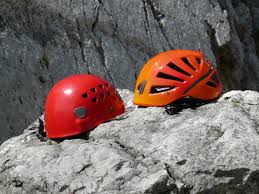|
Climbing is an exhilarating sport that challenges both your body and mind. Whether you’re scaling towering cliffs, navigating tricky boulders, or even climbing indoors, safety should always be your top priority. One essential piece of safety gear that often gets overlooked is the climbing helmet. In this blog, we’ll explore why wearing a climbing helmet is so important, the protection it offers, and how to choose the right one for your adventures.
|

Why is Wearing a Climbing Helmet Important?
|
When you’re out climbing, you’re constantly exposed to potential hazards. A climbing helmet serves as your first line of defence against a range of dangers that can happen at any time. Here’s why wearing a helmet is non-negotiable:
|
Protection from Falling Rocks and Debris:
- When you’re climbing outdoors, especially in areas with loose rock, there’s always a chance of falling debris. Rocks, twigs, and even gear dropped by other climbers can pose a significant risk. A helmet protects your head from serious injury if anything comes tumbling down from above.
Head Protection During Falls:
- Even the most experienced climbers can lose their footing or grip. If you fall, especially on lead climbs, there’s a chance of swinging into the rock face or hitting your head on the wall or ground. A helmet can cushion the impact and potentially save your life.
Protection From Gear Falls:
- In multi-pitch climbing or trad climbing, climbers often carry a lot of gear. Sometimes, this gear can come loose and fall. A helmet offers protection against these unexpected impacts.
Peace of Mind:
- Wearing a helmet gives you an extra layer of confidence. Knowing you’re protected allows you to focus more on your climbing technique and less on worrying about potential hazards.
|

When Should You Wear a Climbing Helmet?
|
The short answer: Always! Whether you’re climbing indoors or outdoors, there’s no good reason to skip wearing a helmet. Here’s when you should be particularly vigilant:
- Outdoor Climbing: Falling debris, loose rock, and unpredictable weather make helmets essential for any outdoor climb.
- Trad and Multi-Pitch Climbing: The risk of gear falling from above or accidental impacts with the rock face is higher in these more complex climbs.
- Bouldering Outdoors: Even though bouldering usually happens closer to the ground, wearing a helmet can protect you during unexpected falls or tumbles.
- Sport Climbing: Even with pre-installed anchors, there’s still a risk of hitting your head during a fall, making helmets just as important in sport climbing.
|

Common Excuses for Not Wearing a Helmet—and Why They Don’t Hold Up
|
Despite the clear benefits, some climbers still skip the helmet. Let’s tackle some of the common excuses and why they don’t hold up:
- “It’s Uncomfortable”: Modern climbing helmets are designed to be lightweight, well-ventilated, and comfortable for all-day wear. It’s worth trying different models to find one that fits well and feels good.
- “I Don’t Need It Indoors”: While indoor climbing gyms are controlled environments, accidents can still happen. Helmets can protect you from falls or collisions with the wall, especially when lead climbing.
- “It’s Too Hot”: Many helmets come with excellent ventilation to keep your head cool. Plus, the safety benefits far outweigh any temporary discomfort.
- “It Doesn’t Look Cool”: Safety is always in style! Plus, with the variety of designs and colors available, you can find a helmet that suits your style while keeping you safe.
|

How to Choose the Right Climbing Helmet
|
Not all helmets are created equal, so it’s important to choose one that suits your climbing style and personal preferences. Here are some tips for picking the right helmet:
- Fit: The helmet should fit snugly on your head without being too tight. Look for adjustable straps and a secure closure system.
- Weight: Lighter helmets are generally more comfortable, especially for long climbs, but make sure they still offer adequate protection.
- Ventilation: Good ventilation is key for comfort, especially in hot weather. Choose a helmet with plenty of air vents if you tend to overheat.
- Durability: Look for a helmet made from durable materials that can withstand multiple impacts. Some helmets are designed to be more robust for trad and alpine climbing.
- Certification: Ensure the helmet meets the safety standards set by organizations like UIAA (International Climbing and Mountaineering Federation) or CE (Conformité Européenne).
|

My Recommendations
|
Recommendation under £50 – Kong Mouse Helmet
- If you’re looking for a helmet that’s light, comfortable, and well-ventilated, the Kong Mouse is a fantastic choice for mountaineering, rock climbing, via ferrata, and adventure parks. Its ultra-durable ABS shell and quick-adjust wheel system ensure a secure fit, while the marked holes make it easy to attach headphones and a visor. The universal size (52-64 cm) fits most heads, and you can choose from a range of colors, including a sleek rubberized black “Soft Touch” finish. Whether you’re hitting the crag or exploring an adventure park, the Kong Mouse has got you covered.
Recommendation under £100 – PETZL, Meteor, Climbing Helmet And Mountaineering
- The PETZL Meteor is a top-tier climbing and mountaineering helmet, perfect for those who value both safety and comfort. Weighing just 225 grams, it’s incredibly light and compact, making it easy to wear for extended periods. The helmet’s excellent ventilation keeps you cool on intense climbs, while the reinforced protection ensures you’re well-covered. With a headband range of 48-58 cm, it offers a snug fit for various head sizes. Plus, it meets multiple safety certifications, including UIAA and UKCA, making it a reliable choice for both climbing and ski touring adventures.

Pingback: Best Climbing Helmets of 2025: Stay Safe in Style - gearyourgrip